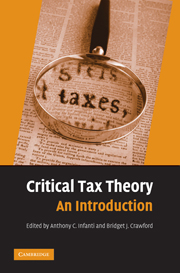Book contents
- Frontmatter
- Contents
- List of Illustrations
- List of Tables
- List of Contributors
- List of Common Abbreviations
- Introduction
- CHAPTER 1 FOUNDATIONS OF CRITICAL TAX THEORY
- CHAPTER 2 HISTORICAL PERSPECTIVES ON TAXATION
- CHAPTER 3 THE GOALS OF TAX POLICY
- CHAPTER 4 CRITICAL TAX THEORY MEETS PRACTICE
- CHAPTER 5 RACE AND TAXATION
- CHAPTER 6 GENDER AND TAXATION
- CHAPTER 7 SEXUAL ORIENTATION AND TAXATION
- CHAPTER 8 THE FAMILY AND TAXATION
- CHAPTER 9 CLASS AND TAXATION
- CHAPTER 10 DISABILITY AND TAXATION
- CHAPTER 11 GLOBAL CRITICAL PERSPECTIVES ON TAXATION
- CHAPTER 12 CRITICAL PERSPECTIVES ON CRITICAL TAX THEORY
- Index
CHAPTER 1 - FOUNDATIONS OF CRITICAL TAX THEORY
Published online by Cambridge University Press: 04 August 2010
- Frontmatter
- Contents
- List of Illustrations
- List of Tables
- List of Contributors
- List of Common Abbreviations
- Introduction
- CHAPTER 1 FOUNDATIONS OF CRITICAL TAX THEORY
- CHAPTER 2 HISTORICAL PERSPECTIVES ON TAXATION
- CHAPTER 3 THE GOALS OF TAX POLICY
- CHAPTER 4 CRITICAL TAX THEORY MEETS PRACTICE
- CHAPTER 5 RACE AND TAXATION
- CHAPTER 6 GENDER AND TAXATION
- CHAPTER 7 SEXUAL ORIENTATION AND TAXATION
- CHAPTER 8 THE FAMILY AND TAXATION
- CHAPTER 9 CLASS AND TAXATION
- CHAPTER 10 DISABILITY AND TAXATION
- CHAPTER 11 GLOBAL CRITICAL PERSPECTIVES ON TAXATION
- CHAPTER 12 CRITICAL PERSPECTIVES ON CRITICAL TAX THEORY
- Index
Summary
Grace Blumberg is the original critical tax theorist. Many scholars and commentators before Blumberg critiqued U.S. tax law and policy, but Blumberg was the first to offer a systemic analysis of the tax law's negative impact on a disempowered group – in this case, women. Writing in 1971, Blumberg called the tax disincentives against women's paid labor “an instrument of social control.” Blumberg pointed at the Code as inappropriately influencing women's career choices: “If the right to work is understood as a fundamental individual right, every individual should be afforded a neutral context in which to make a decision about work.” Blumberg's scholarship is especially remarkable when placed in its historical context.
In the year that Blumberg's article was published, sex equality gained its first jurisprudential foothold when the U.S. Supreme Court decided Reed v. Reed, the first important gender discrimination case. In Reed, the Court invalidated a state statutory preference for a male administrator of an intestate estate. Two years later, in Frontiero v. Richardson, the Court held that it was unconstitutional to require a female member of the military to prove dependency of her spouse in order to obtain certain benefits, when a male member of the military was not required to do so. Finally in Craig v. Boren, the Supreme Court articulated its “intermediate” scrutiny standard to be applied in gender discrimination cases, when it invalidated state liquor laws that treated women as a class differently from men as a class. Blumberg's cogent critique of the tax laws was ahead of its time.
- Type
- Chapter
- Information
- Critical Tax TheoryAn Introduction, pp. 1 - 2Publisher: Cambridge University PressPrint publication year: 2009



